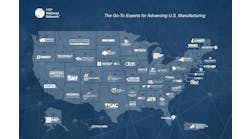Electric and hybrid vehicles are seen as somewhat of a modern marvel that could significantly cut fossil-fuel consumption and greenhouse-gas emissions. But as many car enthusiasts know, the electric car actually dates back more than a century.
By the 1970s, an energy crisis fueled more electric-car innovations, including the introduction of the Sebring-Vanguard Citicar in 1974.
IndustryWeek covered this renewed interest in battery-powered cars at the third-annual Electric Vehicle Symposium in 1974.
At the time, about 30 companies were trying to build and sell electric vehicles, wrote IW Resident Editor James Overbeke, who was based in Detroit.
"The best available can rarely go 100 miles at 50 mph ," Overbeke wrote. "Also, they require 5- to 7-hour periods on the recharger - which delights electric utilities; electric vehicle battery recharging is generally done at night when power is plentiful and wholesaled to large users."
Electric vehicles would likely gain traction in industrial and commercial applications such as lift trucks and golf carts, said J.M. Warring, who was managing director of Harbilt Electric Vehicles in market Harborough, England.
From IW's June 3, 1974 issue:
Electric Vehicle Industry Sounds a 'Charge!'
By James E. Overbeke
The Third Annual Electric Vehicle Symposium had an urgency about it which set it apart from the two previous gatherings sponsored by the Electric Vehicle Council, a coordinating group made up of representatives of investor-owned utilities and manufacturers of electric hardware.
While past meetings might have smacked of "pie-in-the-sky prophecy," the energy crisis coupled with pollution deadlines forced those attending into the spotlight, ready or not.
For years they have been apologists, arguing that low operating costs and clean running justified electric vehicles in the face of their limited operating range. In defense, they would also point out that high-density batteries are surely just around the corner, which they believed would swing all logic to electrics.
This year, however, the builders of electric vehicles have taken this position: "This is what we have; here is how it works; try it." However, there is still a great deal of talk and much hope surrounding superbatteries.
We're misunderstood
Of course, the real glamor item is the battery-powered urban automobile. Now, about 30 companies are trying to build and sell them, even though the best available can rarely go 100 miles at 50 mpg. Also , they require 5- to 7-hour periods on the recharger - which delights the electric utilities; electric vehicle battery recharging is generally done at night when power is plentiful and wholesaled to large users.
To read the full article in its original format, click here:
See also:
Is Plug-In Recharging a 'Non-Starter' for Electric Vehicles?
Charged Up About Electric Cars
New Hope for the Electric Car Industry Comes with Eaton Corp. Grant



